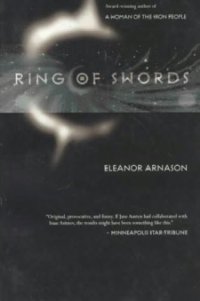Ring of Swords is a lovely example of my very favourite kind of SF, the kind with spaceships and aliens. It’s a book that begs for comparison with Cherryh, because its central character is a man who has betrayed the human race to join the alien hwarhath. That man, Nicholas Sanders, is seen through his own journal and through the eyes of Anna Perez, a human researcher into other intelligent species. (Anthropologist is a very human-centric word.)
If Arnason wrote as much as Cherryh I think I’d like her as much as Cherryh. Unfortunately she has written only five novels, of which I’ve only read three. None of them ever had British editions and all of them are hard to find. I discovered her with her awesome novella “Potter of Bones” in F&SF in 2002, which is about the discovery of the theory of evolution in an entirely alien culture. I’ve been trying to catch up on her ever since.
Ring of Swords is one of those books that draws you in gradually. It starts with Anna investigating some weird and possibly intelligent jellyfish, and then being drawn in to the potential peace negotiations between humanity and the hwarhath. The stakes are huge—the potential destruction of the human race, or of the hwarhath—but the story is small scale, close up and enclosed. The fascinating hwarhath cultures (they have two, one for each gender) and their reaction to human culture are seen in terms of their best male playwright translating Macbeth, their provision of “human chow,” and the rich colours in the heart of all the grey steel.
This is a book of alien anthropology with wonderful characters, human and alien. And it’s a lot of fun. It starts quietly and fairly conventionally, but as you keep reading it becomes entirely absorbing. This was my second reading, and I dreamed about the hwarhath all last night.
There’s a strand of feminist SF that does “separating the nasty rough men and lovely civilized women.” (Shore of Women, The Gate to Women’s Country, Glory Season, Native Tongue, and most recently a fascinating re-examination of the trope by Le Guin’s “The Matter of Seggri” in The Birthday of the World.)
I’ve always said I’d like that sort of thing better if they wrote it about aliens, because human women in my experience can be just as awful as human men, and that’s what Arnason does. (I appreciate it. It’s much easier on my suspension of disbelief.) In all of those stories I just cited, the men and women come together for sex and procreation. The hwarhath take this a stage further and do not. They are intensely homophilic and also consider homosexuality proper and right. They reproduce using modern technology—probably in vitro fertilization. They pay great attention to lineages and clans, which seems to be the one thing that keeps their utterly separate societies functioning together. The females consider the males by definition violent and wild. But Arnason is more subtle than most who deal with this theme. As with Cherryh’s Hani there are hints that this “inherent” violence may not (or may no longer) be entirely the case—the male hwarhath that we see are capable of controlling themselves. Also Arnason is well aware that human females are not angels—the worst human we see in the novel is a woman. Beyond that, she shows us a sexual deviant hwarhath who is attracted to women, but who can’t come close to any women in their entirely separate world.
The hwarhath males are out in space looking for an enemy, an enemy who will fight them while observing the laws of war—not attacking civilian populations. Humanity horrifies them because of our perverse and animal-like heterosexuality, and because we don’t fight fair.
There is a sequel promised which has not yet been forthcoming—I don’t know what happened to it, but I’d love to see it, especially if Ring of Swords were to be republished at the same time.










